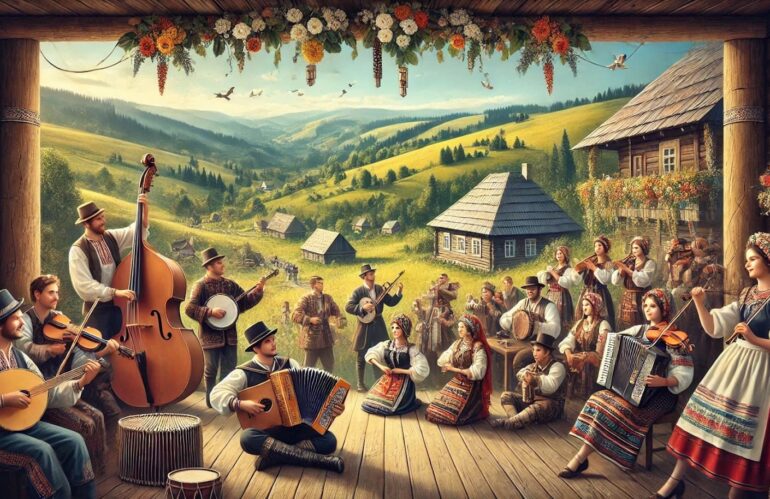Folk music in Eastern Europe has played a crucial role in the cultural development and identity of the region. Rooted in ancient traditions, it reflects the values, struggles, and stories of local communities. Passed down through generations, this music was often used to express emotions, mark important life events, and communicate cultural beliefs. The melodies, rhythms, and lyrics of Eastern European folk music capture the essence of the landscapes, social structures, and everyday life, making it an invaluable window into the region’s history and cultural fabric. Folk music has a profound connection with the people, preserving their language, customs, and history over centuries.
Throughout history, Eastern European folk music has been shaped by a diverse range of influences. The region’s complex mix of ethnic groups, languages, and religions has fostered a rich and varied musical tradition. From the Slavic chants of the early medieval period to the gypsy and Ottoman influences that permeated the region, Eastern European folk music evolved in a distinctive way, yet always remained closely tied to the people’s traditions. Despite political upheavals, wars, and cultural shifts, folk music has remained a constant form of cultural expression, symbolizing resilience and the enduring spirit of the people. This article explores the origins, development, and significance of folk music in Eastern Europe, tracing its journey from ancient times to the present day.
Overview of Folk Music
Folk music is a genre of music that originates from the traditions of a particular community or culture, often passed down orally through generations. It typically reflects the everyday experiences, values, and stories of the people who create it, serving as a form of expression for cultural identity, social bonds, and historical memory. Unlike popular or classical music, folk music is generally more accessible and rooted in local customs, traditions, and natural sounds. It often features simple melodies and rhythms, using traditional instruments that have been adapted and passed down over time, such as fiddles, guitars, and flutes.
Folk music has been an essential part of many societies, providing a means of storytelling, celebration, and communication. It is closely tied to the lives of working-class communities, reflecting themes like love, work, struggle, nature, and national identity. Over time, folk music has adapted to societal changes, blending with other musical styles and modern influences while retaining its core themes and accessibility. In some regions, folk music has evolved into subgenres, incorporating modern instruments and techniques. Despite this, the heart of folk music remains in its roots, representing a vibrant and dynamic cultural heritage.
History Guide of Folk Music in Eastern Europe
Folk music in Eastern Europe is an intricate tapestry of diverse traditions, reflecting the region’s rich cultural, historical, and social landscape. From the early Slavic tribes to modern-day nations, folk music has played a central role in shaping national identities, expressing emotions, and preserving local customs. The history of Eastern European folk music is shaped by a variety of influences, including interactions with neighboring cultures, religious movements, political events, and the resilience of local communities who maintained their musical heritage despite numerous external pressures.
Early Beginnings and Ancient Traditions
The roots of folk music in Eastern Europe date back to the early days of the region’s settlements, with musical practices largely influenced by oral traditions. The earliest folk music was vocal, often accompanied by simple percussion instruments such as drums or bells. This music was deeply connected to the agricultural cycles, marking events like harvests, planting seasons, or community festivals. Early Slavic, Baltic, and other indigenous cultures used folk songs to narrate stories, express rituals, and communicate with the gods. These early traditions were passed down through generations, forming the backbone of what would later evolve into more distinct regional styles.
Middle Ages and the Influence of Christianity
As Christianity spread across Eastern Europe, it had a significant impact on folk music. Church music, particularly liturgical chants, merged with pre-existing folk traditions, creating a unique blend of sacred and secular sounds. This was especially evident in the development of the Slavic choral tradition. Folk songs became an essential part of life in medieval communities, accompanying everything from weddings and births to funerals and wars. The interaction between Christian hymns and local folk traditions led to the creation of regional styles that would continue to evolve in later centuries.
Renaissance to the Baroque Period
During the Renaissance and Baroque periods, folk music in Eastern Europe began to incorporate more complex forms and structures. As trade and cultural exchanges increased, particularly through the influence of the Ottoman Empire and other Western European powers, Eastern European folk music absorbed new instruments and musical techniques. The introduction of stringed instruments such as the violin and lute contributed to the development of more intricate melodies and harmonies. Folk music began to be more widely performed at court and in noble circles, though it still retained its close ties to rural life and peasant traditions.
The 19th Century: Nationalism and Romanticism
The 19th century was a turning point for folk music in Eastern Europe. The Romantic movement, with its focus on nationalism and the celebration of folk culture, led to a renewed interest in preserving and reviving traditional music. As various Eastern European nations sought to define their identities in the face of foreign domination and internal divisions, folk music became a symbol of national pride. Musicologists and folklorists began collecting, recording, and transcribing traditional songs, ensuring their survival for future generations. Folk music was no longer just a rural practice; it became a tool for fostering national unity and resistance to foreign rule.
The 20th Century: Political Turmoil and Folk Music Revivals
The 20th century brought significant political upheaval to Eastern Europe, with both World Wars and the rise of communism profoundly impacting folk music traditions. During the Soviet era, governments often used folk music for political purposes, promoting state-sponsored versions of national folk traditions while suppressing local variations. Despite these efforts to control folk music, underground movements and cultural preservation societies kept traditional music alive, leading to several folk music revivals in the mid-20th century. In the 1960s and 1970s, folk music saw a resurgence as part of broader movements advocating for cultural freedom and identity.
Future of Eastern European Folk Music
The future of Eastern European folk music lies in a dynamic balance between honoring tradition and embracing modern innovation. While musicians blend folk melodies with contemporary genres like pop, rock, and electronic music to engage new audiences, dedicated efforts continue to preserve and pass down authentic sounds. This evolving landscape ensures that folk music remains culturally relevant while maintaining its unique regional identity.
Key trends shaping the future of Eastern European folk music:
- Fusion with modern genres such as pop, rock, jazz, and electronic.
- Use of contemporary production techniques alongside traditional elements.
- Increased global exposure through streaming platforms and social media.
- Digital preservation of historical recordings and folklore.
- Revival of traditional instruments by younger generations.
- Continued organization of folk festivals that support both preservation and innovation.
- Cultural programs that promote folk music education and heritage.
- Growing collaborations between folk artists and mainstream musicians.
Conclusion
The history of folk music in Eastern Europe is a rich and dynamic journey that reflects the region’s cultural diversity, historical complexities, and resilience of its people. From its ancient roots in the agricultural and spiritual traditions of early Slavic and indigenous communities to its role in shaping national identities during periods of political turmoil, folk music has consistently served as a powerful form of cultural expression. Despite external influences and changing political landscapes, Eastern European folk music has survived through the efforts of musicians, scholars, and cultural movements dedicated to preserving and revitalizing these traditions.






